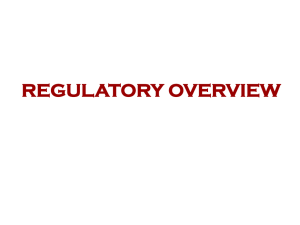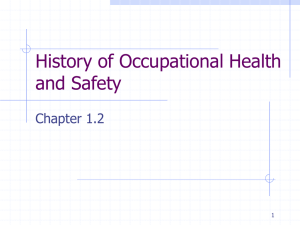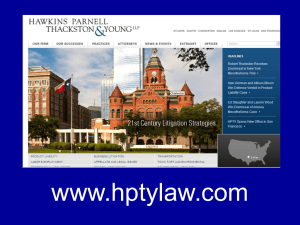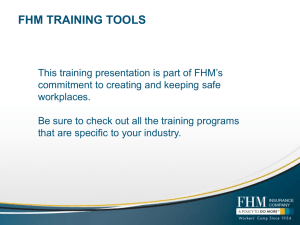Asbestos Issues for Facility Management
advertisement
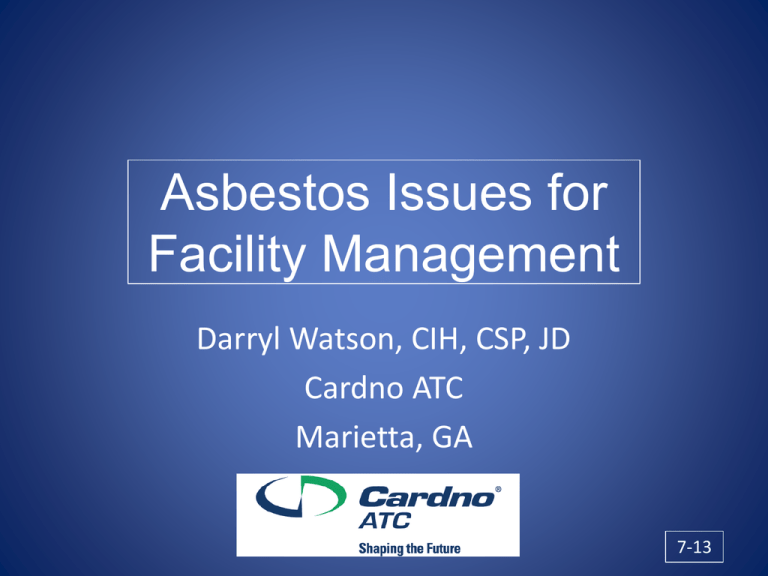
Asbestos Issues for Facility Management Darryl Watson, CIH, CSP, JD Cardno ATC Marietta, GA 7-13 Asbestos in Use • There are more the 3000 products that have contained asbestos – Some were made in the US, some imported – Almost all building products contained asbestos at one time or another – There has never been a regulation that requires the removal of asbestos from buildings merely because it is present – Nor have all asbestos-containing materials been banned in the US 6 Regulated Asbestos Minerals • Chrysotile - most common – White – >90% of products in US • Amosite - less common - Brown • Crocidolite - uncommon – Blue – Amosite & crocidolite most common in pipe & boiler insulation • Others - Tremolite, Actinolite, Anthophyllite sometimes found as contaminants with other minerals such as talc and vermiculite Asbestos Containing Materials (ACM) • A material containing >1% asbestos – A term global to EPA and OSHA • Accredited Inspectors perform surveys and issue reports • Sample Analysis – ACM has to be determined using laboratory techniques, not by “naked” eye – “Bulk” samples are analyzed by polarized light microscopy (PLM) – Results contain type and percentage of asbestos and other fibrous material Friable & Intact ACM • Friable (EPA): material, that when dry, may be crumbled, pulverized or reduced to powder by hand pressure – EX: Such pipe insulation or fireproofing • Intact (OSHA): means that the ACM has not crumbled, been pulverized, or otherwise deteriorated so that the asbestos is no longer likely to be bound with its matrix. Surfacing material (SM) – Material that is spray or trowel applied; generally to ceilings and structural steel Modern non-ACM Fireproofing Can look like older ACM fireproofing ACM fireproofing banned in 1973 Thermal System Insulation (TSI) • Insulation materials on systems such as: boilers/steam delivery, chilled water, condensate returns and ductwork • Prevents heat gain or loss If undamaged.. EPA & OSHA allow in-place management Undamaged TSI Badly Damaged TSI “Air Cell” Corrugated Insulation Miscellaneous Materials • A broad spectrum of ACM’s that do not fall into the categories SM or TSI Resilient Floor Coverings (RFC) Floor Tiles, Linoleums, and Mastics (glue) In good shape on the left Damage on the right should be repaired or removed Wallboard Joint Compound & Tape Recent construction Older construction Asbestos? Asbestos Packing & Gaskets New! Corrugated Asbestos Cement Board Corrugated Cement Sheet Roof Panel Asbestos Cement Pipe Fire Rated Doors Ceiling Tiles Some ceiling tiles do contain asbestos, but they are not common Roof Felts, Coatings and Flashing Roof materials (flashing, cements and coatings) may STILL contain asbestos materials in new construction Electrical Applications Asbestos cloth used to insulate electrical lines Federal Asbestos Regulations Common to day-to-day asbestos control work OSHA EPA NESHAP AHERA 40 CFR Part 61 Subpart M 40 CFR Part 763 Demolition, renovation and waste issues K-12 schools, public and private Inspections & Assessments Inspections prior to disruption Management Plans Notifications Communication Required removal Training requirements Waste packaging & approved landfills Waste shipment records Always check for State/Local program requirements! Abatement final clearance issues Worker Protection Rule 40 CFR Part 763 Subpart G OSHA protection for those in State/Municipal employment General Industry Construction 29 CFR 1910.1001 Permissible exposure limits and exposure assessments Permissible exposure limits and exposure assessments Inspection before exposures Communication Worker protection; Respiratory protection must meet 29 CFR 1910.134 Training Mandatory appendices 29 CFR 1926.1101 Inspection before exposures Communication Worker protection; Respiratory protection must meet 29 CFR 1910.134 Classes of asbestos disturbing work (I-IV) Significant work practice requirements Training Mandatory appendices OSHA – Definitions • Presumed Asbestos Containing Material (PACM) – Surfacing Materials and TSI in buildings constructed through 1980 – Also: (k)(1)(i) Flooring and Adhesives installed in buildings constructed through 1980 • This was not a ban! – OSHA has not banned any ACM • Also of note: (k)(1)(1)(i) - Other materials that are known or should have known to contain asbestos; “due diligence” (simply; sample before exposure) OSHA Communication Requirements of the Owner • 1926.1101(k)(2)(ii) – Inspect for ACM/PACM Prior to Disruption • “Before work subject to this standard is begun, building and facility owners shall determine the presence, location, and quantity of ACM and/or PACM at the work site…” – In most cases, this will require an accredited inspector following AHERA survey requirements OSHA Communication Requirements of the Owner • 1926.1101 (k)(2) – Notify the Following: • • • • Prospective Employers applying or bidding for work Employees of the Owner Multi-employer worksite employers and employees Tenants – Applies to commercial renters, not apartment dwellers etc. • This applies to those in or adjacent to areas containing such material OSHA Communication Requirements of the Owner • Employers working at the Owner’s site have responsibilities, 1926.1101 (k)(4) – …all employers who discover ACM and or PACM…shall convey info concerning presence, location & quantity…newly discovered ACM/PACM to the owner, other employers of employees…within24 hours • General contractors: have responsibility to assure that the abatement contractor is in compliance EPA NESHAP Use/Installation Bans • • • • 1973 (fireproofing), 1976 (TSI, spray/toweled acoustical) and 1978 (decorative material), The following asbestos containing materials are banned: • • • • • • Corrugated Paper Rollboard Commercial Paper Specialty Paper Flooring Felt Any other new uses of asbestos • 1977 CPSC, asbestos tape & joint compound – Homes & schools, persisted commercially for some time, imports ACM Not Banned • There are many products yet in the market place that can get into new construction – ACM not subject to the current bans…a few: • asbestos cement – corrugated and flat sheet – asbestos cement pipe – asbestos cement shingle • • • • pipeline wrap vinyl asbestos floor tile millboard asbestos clothing • Friction products – disc brake pads – drum brake linings – automatic transmission components – clutch facings – brake blocks • gaskets & packings • roofing products – typically flashing & cements • caulks, putties, glues & mastics of all kinds Asbestos Inspections • The terms “survey” is most commonly used today • Surveys are required by regulations under: – AHERA – Schools K-12; requirements are well defined within the regulation – NESHAP; Demo/Renovations, must inspect for all possible ACMs prior to disruption; notifications – OSHA; Worker protection; inspection and communication before disruption Environmental Site Assessments (ESA) or “Phase I” • These are NOT designed to meet regulatory requirements as an asbestos inspection – ASTM E-1527-05…asbestos is excluded • Despite reporting language (caveats) in the ESA report…clients often believe they have an asbestos inspection • Limited asbestos surveys or “screens” (ASTM E2308) are also NOT compliant with required regualtion-required sampling protocols AHERA Requirements • Must sample the following and categorize: • Surfacing Materials – Fireproofing, textured ceilings etc. • Thermal System Insulation – Pipe and boiler insulation etc. • Miscellaneous Materials – Basically everything else; floor tiles, ceiling tiles, wallboard joint compound, mastics, etc. • Assess All Friable Materials – And non-friable ACM which have become friable – This is to describe the condition of the friable ACM • For management purposes OSHA Requirements • For buildings constructed before 1981, suspect surfacing material and TSI must be assumed to be ACM or tested • Sheet flooring or floor tiles & mastics installed before 1981 must be assumed to be ACM or tested • OSHA “due diligence” for any material • Must sample and communicate prior to disruption – Sample BEFORE exposure; may be limited in scope • The sampling and analytical portion of the survey must be conducted in accordance with AHERA NESHAP Requirements • National Emission Standard for Hazardous Air Pollutants (NESHAP) – Demolition and renovation activities & waste – NESHAP requires: • inspection prior to disturbance – A THOROUGH survey! – NESHAP has no “end date” when surveys must be performed – An AHERA survey is often not adequate; usually do not sample exteriors or perform invasive sampling (walls, floors) • categorize based on friability (NESHAP categories) • removal of RACM prior to renovation or demolition • notification for all demos and most renovation activities Managing Survey Data • An asbestos survey acts as your inventory of what materials are ACM and where they are found • A survey is only useful in the long term IF that inventory is kept up to date! • This requires management of when ACM is removed and to then update the survey info Managing Survey Data • The old school method: the file cabinet – Can you or your staff access this when needed? • The new school; electronic data management of this info – Allows for easier access to data and for updating as materials they are removed – Spreadsheets or databases, CAD drawings, GIS system info – Whichever is chosen, it needs to be standardized across offices Managing Survey Data • The bottom line: – Can you inform a staff member or contractor if a material that will be disturbed is ACM or not?! – Can you plan for renovations or demo? • Proactive vs. Reactive • EPA asbestos NESHAP requires a thorough survey before renovation or demo & removal of RACM as required – Can you plan for operations & maintenance (O&M) • Applies to in-house and subcontracted work Types of Certifications • EPA & OSHA require those that perform asbestos work are certified – Asbestos Inspector; performs the survey – Management Planner; write O&M plans etc. • Certification a matter for school work (AHERA) – Project Designer; those that write plans/specs for abatement activities – Supervisor/Worker; those that perform/manage abatement activities – Project Monitors; those that manage abatement activities and provide air sampling services • Certification is by State/Local program here – State/Local program may also require licensing In-house or Subcontracted ACM survey • Depends on the scope of the survey – AHERA? NESHAP? OSHA? • What is the purpose? – If subcontracted remember to define • What will be sampled/assumed? – EPA and OSHA allow “assume” ACM • What will be quantified? How accurately? • What will be accurately located on a floor plan? • What is the deliverable; the final report? In-house or Subcontracted Abatement? • O&M or removal – Can be performed in-house • Training, medical monitoring, fit testing, waste issues, specialized equipment (HEPA vacuums, glovebags etc.)…. – Subcontractor • Availability of qualified, certified firms – In some areas these are abundant, not all • Cost – Level of detail of work, location of client, State/Local regs – Facility security issues; nights/weekends? badging? OSHA Classes of Work Knowing these work classes is important • Class I – Removal of surfacing material, TSI or PACM – Training: 4 day worker, 5 day supervisor (AHERA) – Can perform all classes of work • Class II – Removal of other than surfacing and TSI – EX: flooring, ACM cement siding, mastics, roofing, wallboard – Training same as Class I if all Class II performed – Single media (task) 8 hr min worker training • If trained to one type of work; roofers common – Supervisors: in most cases 5 day training OSHA Classes of Work – Class III • Asbestos Surveys; Inspector is subject to Class III requirements • Maintenance & Repair • Non-removal (same as AHERA O&M) • 1 glovebag, mini-enclosures (2 workers max.), 1 waste bag (1/3 – 1/2 full), 60”x60” bag max • 16 hour training – Class IV • Maintenance & custodial cleaning activities, incidental contact or incidental to construction (Class I, II, III) • 2 hour awareness training All work classes have annual refresher requirements Closing the Loop • No matter if the survey or abatement is completed by a vendor or in-house… – If the data in not managed, the program will fail • Cost of periodic re-inspections • Cost of reactive responses and OSHA matters • ACM disturbance issues – A program must be managed or liabilities can result that can be disruptive and expensive Questions? Thank you! Darryl Watson, CIH, CSP, JD Cardno ATC Marietta, GA


